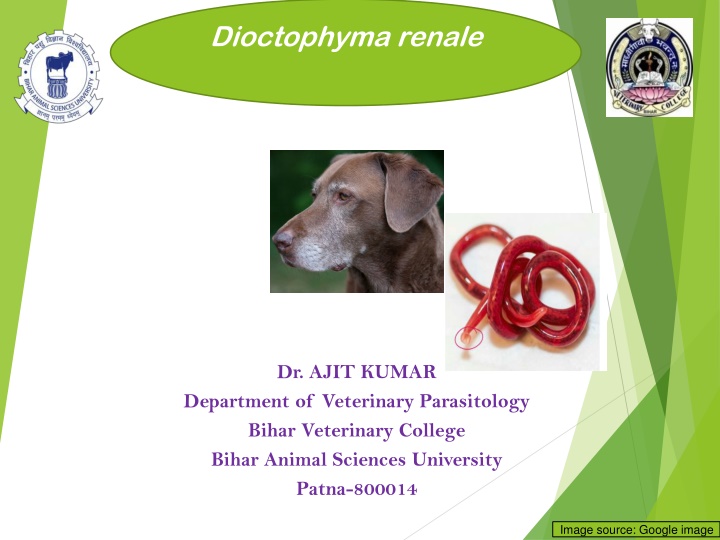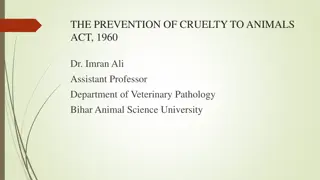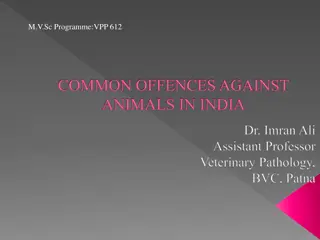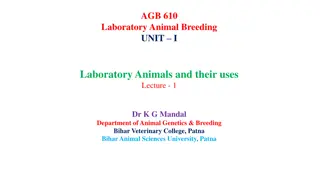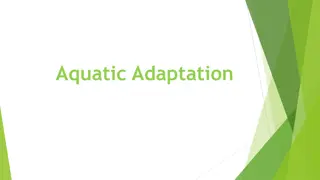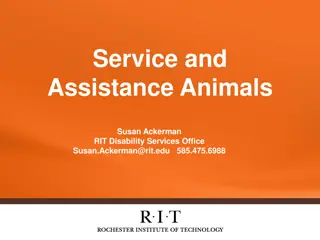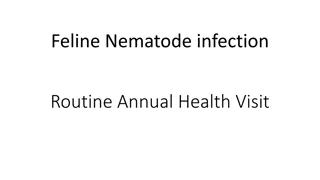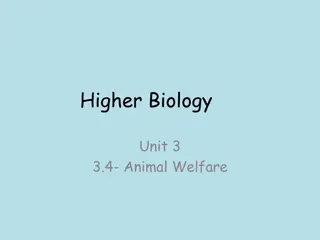Dioctophyma Renale: Largest Nematode of Domestic Animals
Dioctophyma renale, also known as the Giant Kidney Worm of dogs, is the largest nematode infecting domestic animals. This parasitic worm typically infects the kidneys of final hosts such as dogs, foxes, and minks. Its life cycle involves an indirect pathway through an intermediate host, the Oligochaete annelid Lumbriculus variegatus. Infection in the final host occurs through ingestion of larvae from the intermediate host or paratenic hosts like fish or frogs. The pathogenesis of Dioctophyma renale involves destructive actions in the kidney parenchyma, leading to clinical signs such as dysuria, haematuria, and renal colic. Understanding the characteristics and life cycle of this parasite is crucial for effective diagnosis and treatment in veterinary parasitology.
Download Presentation

Please find below an Image/Link to download the presentation.
The content on the website is provided AS IS for your information and personal use only. It may not be sold, licensed, or shared on other websites without obtaining consent from the author.If you encounter any issues during the download, it is possible that the publisher has removed the file from their server.
You are allowed to download the files provided on this website for personal or commercial use, subject to the condition that they are used lawfully. All files are the property of their respective owners.
The content on the website is provided AS IS for your information and personal use only. It may not be sold, licensed, or shared on other websites without obtaining consent from the author.
E N D
Presentation Transcript
Dioctophyma renale Bihar Animal Sciences University | Dr. AJIT KUMAR Department of Veterinary Parasitology Bihar Veterinary College Bihar Animal Sciences University Patna-800014 Image source: Google image
Dioctophyma renale Family: Dioctophymidae Other name: Eustrongylus gigas Common name: Giant kidney worm of dog
Dioctophyma renale General Characters: Largest nematode of domestic animals (Length of female is up to 103 cm). Worms are blood red in colour. Male worm (35-45 cm long) has single spicule and cup-shaped bursa without bursal rays. Barrel shaped eggs in the single cell stage are passed in the urine, either singly or in clusters or chain and the shells are pitted except at the poles. Egg
Dioctophyma renale Final Hosts : Final Hosts : Dog, fox and mink Location: Location: Kidney Kidney
Dioctophyma renale Life Life- -cycle cycle: : Indirect life-cycle Intermediate host: Oligochaete annelid (Lumbriculus variegatus) Infective stage : 3rd stage larva (L3)
Dioctophyma renale Transmission Transmission: : Final host gets the infection - o by swallowing the L3 larvae infected intermediate host i.e. Oligochaete annelid (Lumbriculus variegatus) with the drinking water OR o by the ingestion of paratenic host like fish (Idus spp.) or frog which has itself eaten the infected annelid.
Dioctophyma renale Life Life- -cycle cycle: :
Dioctophyma renale Pathogenesis: Worms destroy the parenchyma of pelvis of the kidney. Usually right kidney invaded more frequently than the left. Formation of a sac like structure in the capsule where worms are found.
Dioctophyma renale Clinical signs: Kidney worms infection leads to o Dysuria with especially at the end of micturition. Dysuria some haematuria, o Renal colic Haematuria Haematuria
Dioctophyma renale Diagnosis: On symptoms. Microscopic examination of urine reveals eggs of worm. Eggs are shaped, brown colour and the shells are pitted except at the poles. the basis of barrel EGG
Dioctophyma renale Treatment : Worms may be removed surgically.
Dioctophyma renale Control: Providing of clepened water like shallow water. Prevent ingestion earthworms. of Proper cooking of frog and fish before eating by dogs.
THANK YOU
